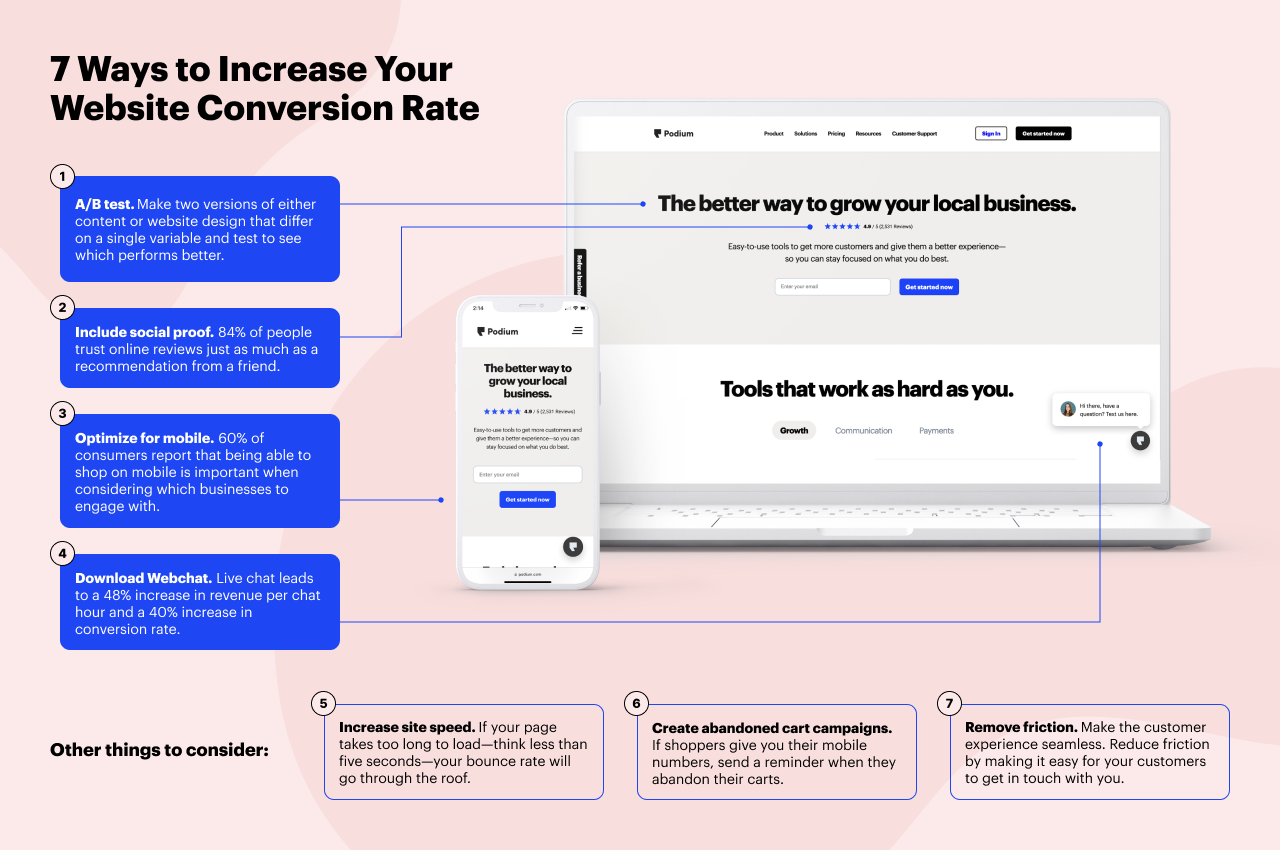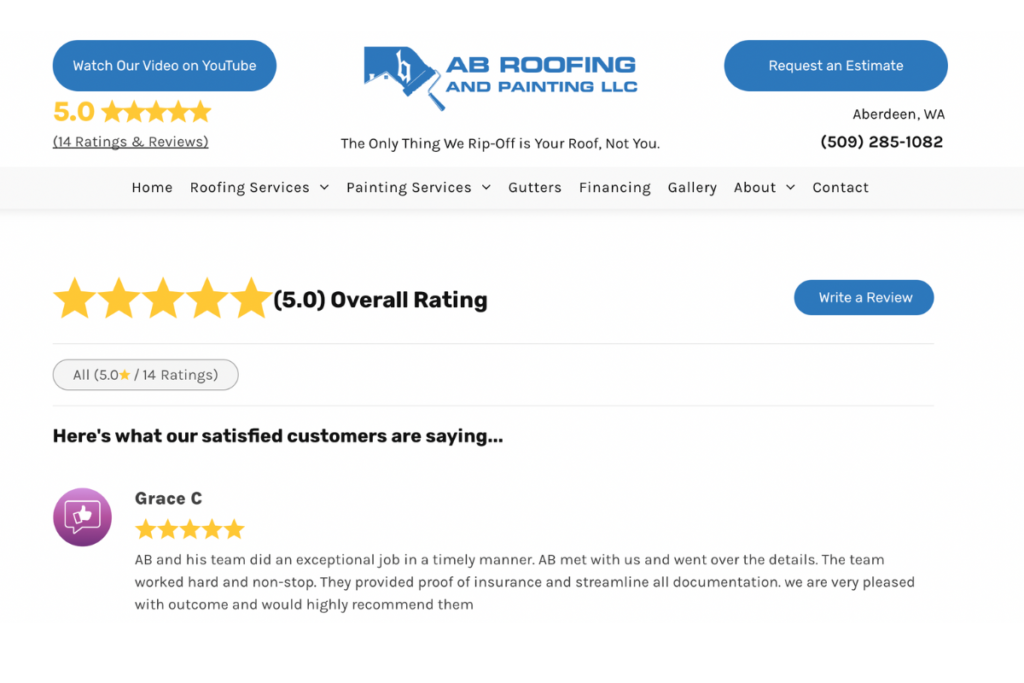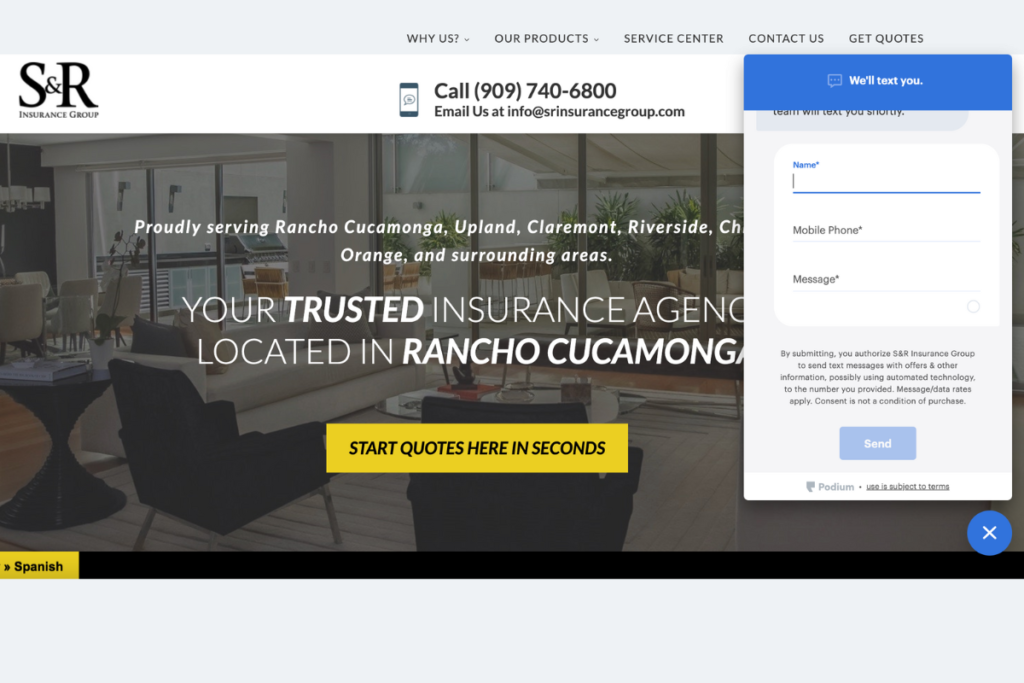Check out these seven website conversion tips and learn about website marketing for small businesses.
Most consumers research a business online before engaging with them. And a staggering 97% of consumers turn to online search to find a local business or service. But in a world of 2 billion websites, it takes more than your typical website design and strategy to win business. So, how do you design a site that converts? We’re here to tell you.
Read on for seven strategies you can try to increase your website’s conversion rate.
What Is a Good Conversion Rate?
The conversion rate is a common key performance indicator (KPI) for many marketing strategies, such as email marketing. But it is also used in measuring website and landing page performance. So, what does a conversion on a website mean?
Conversion on website happens when a visitor completes a desired action. Conversion rate on websites refers to the percentage of website visitors who take some actions on the website or turn into paying customers. You can use it to determine whether your website and marketing efforts are paying off or if you need to make any changes.
The average conversion rate for websites typically sits between two and five percent, though it varies by industry. Typically, conversion rates above five percent are considered high, or “good.” Some industries, however, see conversion rates well above five percent. Variables such as target audience demographic, mode, channel, and industry can affect what is considered “good.”
A good conversion rate indicates your website design and marketing strategy are effective. It also means generating more money. On the other hand, a low conversion rate means something on the website prevents visitors from taking your desired action. It can be difficult site navigation, slow loading speed, unclear call-to-action (CTA), etc.
How to Calculate Website Conversion Rate
Now you get the answer to “What is website conversion?” let’s learn how to acquire the actual rate.
The generally accepted formula for calculating conversion rate is getting the total number of conversions and dividing it by the total number of site visitors in a given time frame. Then, multiply the result by 100 to get the percentage, which will be the conversion rate. For example, if 17 out of 500 website visitors for one month made a purchase, the conversion rate will be 3.4%.
Sounds easy? There’s actually more to it so let’s break that down.
Let’s start by defining visitors and conversions. Visitors refer to people who visit your website. Conversion on website is when the site visitor completes a desired action. It can be anything from signing up for newsletters or completing a form to buying a product and so on. You can break down website conversion into two types: micro conversions and macro conversions.
Micro-conversions are the completion of small steps by a website visitor that lead them to take actions profitable for your business. Examples of these are adding products to a cart or visiting specific pages. Although micro-conversion is not considered part of a site’s overall conversion rate, tracking them enables marketers to spot weak links in their sales funnel and where to focus their conversion optimization efforts.
On the other hand, macro conversions are actions that website visitors take that serve as the main goal of your business. It’s the main thing that the marketing and sales teams are driving site visitors to do, like buying a product, registering for an event, etc.
Some conversion goals may not involve all visitors to your website. For instance, you want your visitors to fill out forms, but the form is only available on certain website pages. In this case, dividing the total number of visitors by the number of conversions won’t give you an accurate conversion rate. You’ll need to use a more tailored formula. Here are a few examples:
- Number of landing page visits divided by the number of forms filled out
- Product page views divided by shopping cart call-to-action clicks
Knowing what exactly you are trying to measure is necessary when calculating your online conversion rate. You will also need some tools to set up a conversion rate tracking dashboard for easy monitoring. Google Analytics is a good option for starters. You can find many other conversion rate optimization tools, and they offer different features.
What Makes a High Conversion Website?
Many factors go into a high conversion website—some obvious, some not so much—and what conversion rate website pages must have. However, all high-conversion websites tend to center around the following: highly engaging content, an effective layout, straightforward communication, experimentation, speed, and contactability.
From displaying testimonials and reviews to removing any distractions and increasing simplicity, there are a lot of things you can do to increase the conversion power of your website.
Now that you know what is a conversion on a website, are you ready to send your site conversion rate through the roof? The following seven tips will not only help you do that but help you improve customer loyalty as well.

7 Strategies to Increase Your Website’s Conversion Rate
Increasing website conversions is done by implementing strategies that work for your business—there isn’t a one-size-fits-all solution that will work for every business. And, because your business and customers need different things at different times, your conversion rate optimization process should be continually changing.
And remember, website optimization should involve constant evaluation of your conversion funnel. So while you may pick a couple of the following conversion tips to try today, don’t rule the others out. We’d recommend starting with a couple, then testing a couple more a month or two down the road. If one strategy doesn’t work well for you, don’t be afraid to pivot.
Now, let’s get into it.
1 – A/B test. Conducting an A/B test (also known as a split test) on your homepage is a great way to see what’s working and what could be improved. To do this, make two versions of either a specific piece of content or an aspect of website design that differ on a single variable. A/B tests can involve very simple tweaks, like the words of your call to action (CTA), the image on your landing page, or the subject line of an email. Then, test these two versions to see which one performs better over a specific period of time. If your website gets lots of daily traffic, A/B testing for a few hours might be enough. If not, you might need a couple of weeks to find out which works best. Conducting A/B tests regularly and using Google Analytics to monitor the results will help you to determine the most productive ways for you to improve your web conversion rate, based on actual market research.
2 – Remove friction. To improve website conversion rates, you want to ensure that every aspect of the customer experience—from finding your business to contacting your business or booking an appointment—can be done with as little friction as possible. To reduce friction, get to know your customers by creating customer personas. Understanding who is buying from you allows you to tailor your website experience specifically to your target demographic. And by making it easy for your customers to get in touch with you, you reduce the likelihood of losing potential business to your competitors.
Pro tip: In our modern marketplace, reducing friction often means using text. Text has been proven to play a significant role in conversion rate optimization.
3 – Create abandoned cart email campaigns. Ah, abandoned carts. Nothing is more haunting than a purchase that was so close to happening but never actually happened. To reduce this issue, we recommend creating abandoned cart email campaigns to remind customers of what they’re missing out on. If online shoppers have given you their mobile numbers, you can also send them a reminder via SMS every time they abandon their online carts. (Think: Hey, [customer name] are you still interested in [product/service]?) And to really seal the deal, make sure your abandoned cart campaigns include a discount offer. Free shipping or 15% off might just be enough to turn an abandoned cart into a happy customer.
4 – Include social proof.Customer reviews and testimonials have the power to influence a person’s decision to do business with you. In fact, 84% of people trust online reviews just as much as a recommendation from a friend. Similarly, nearly two-thirds of consumers say positive customer testimonials increase their trust in a business. Including reviews on your website can be a key factor in convincing customers to click that buy button or visit your store.

5 – Optimize for mobile. To convert, your website needs to perform just as well on a customer’s phone as it does on their computer screen. Mobile performance is rapidly gaining importance as half of eCommerce sales are now made through mobile devices. Furthermore, nearly 60% of consumers report that being able to shop on mobile is important when considering which businesses to engage with. The statistics don’t lie; many people prefer to shop from their phones. If your website doesn’t work well on mobile devices, you’re almost certainly missing out on potential sales.
6 – Increase site speed. Page speed is essential, regardless of the device. Think about it—when was the last time you waited more than a few seconds for a page to load without becoming annoyed or leaving the page altogether? If your page takes too long to load, people will likely click off of your website before they’ve even had a chance to see it in its full glory. Page speed is crucial to your conversion rate and overall user experience. Look for different things that may be slowing your website down, like unnecessary pop-ups, videos, large files, etc., and clear up those issues ASAP. Make sure your website takes only 3 seconds to load.
7 – Download Webchat. Live chat is an up-and-coming communication feature that approximately 41% of customers expect to see when they land on your website, and this kind of convenience pays. By integrating live chat on your website, your business can also respond to inquiries in real time. A fast lead response time is critical in improving conversion rates.
A recent survey reported that live chat leads to a 48% increase in revenue per chat hour and a 40% increase in conversion rate.
Podium’s Webchat has proven to be a make-or-break tool that turns websites into lead-generating machines from the landing pages alone. With Webchat, you can move conversations from desktop to mobile and you ensure that those conversations continue well after people leave your site. You can even give customers the option to pick a specific location to chat with in the case of multiple locations. It’s an effective tool for turning conversations into conversions.

The answer to the question, “How to increase website conversion rate?” is different for every business, but offering your customers world-class contact ability and convenience through the most modern method of communication is certainly a good place to start.
If you’re a small business owner looking to convert more of website visitors into customers, check out this list of strategies for increasing conversion. It includes simple tweaks you can easily make to your website that will help more potential customers go through with purchases.
Tips for Marketing Your Small Business Website
Optimizing your website is just the beginning. Now, it’s time to show off what you’ve done and get your website in front of the right eye. Here are some tips to drive more traffic.
1. Find Your Top Performing Content
There are a few ways to find your website’s top-performing content. First, you can look through your analytics to see which pages have the most traffic and engagement. You can also use keyword research tools to identify what topics and keywords people are searching for the most in relation to your website or industry.
Additionally, you can analyze comments, shares, or other forms of feedback on various pieces of content to get an idea of what is resonating with readers. By understanding how visitors are interacting with your content and which posts/pages generate the highest levels of engagement, you can then focus on creating more content that fits within those parameters.
2. Know Your Audience
Narrowing down your ideal customer can help you create more effective and efficient campaigns. To start, analyze current customer data to get an idea of who is purchasing your products or services most often. You can also identify target demographics based on topics that are relevant to your brand, such as industry-specific content, geographic region, age range, etc.
Additionally, if you use social media platforms to promote your business, you can use analytics to understand engagement with certain posts/ads. This will give you a better understanding of how certain types of content are resonating with different audiences.
3. Check What Your Competitors Are Doing
Conducting a competitive analysis is an important step in developing an effective marketing strategy. Begin by identifying your main competitors and researching their offerings, pricing, target market, and marketing tactics. Monitor their customer reviews and feedback to get a better understanding of how they are appealing to the public. Finally, you should consider conducting surveys or focus groups with potential customers to compare your offering with those of your competitors.
4. Leverage Content Marketing
Content marketing is an effective way to build brand awareness, drive traffic, and increase conversion rates. To get started, create a comprehensive content plan that outlines your goals, key topics to focus on, and the channels you plan to use. You should also identify potential audience segments based on relevant interests and demographics. Once you have a plan in place, create quality content for each channel—whether it’s blog posts, videos, e-books, or social media posts. You might also consider using tools like SEO or advertising to reach more people with your content.
5. Get Active on Social Media
Social media marketing is a powerful way for small businesses to reach new customers and drive sales. To get started, determine which social platforms best align with your goals and target audience. Once you have established your presence on social media, begin regularly creating content that resonates with your target audience. This can include blog posts, videos, images, polls, or quizzes that both entertain and educate users about your product or service. Make sure to track the performance of your content regularly so you can adjust accordingly and maximize results.
6. Optimize Your Google Business Profile
Optimizing your Google Business Profile is a great way to improve the visibility of your small business in the digital world. Start by making sure all of your business info—name, address, phone number, categories, website—is accurate. After that, upload high-quality pictures that best represent your business. Then, consider adding services or special offers to showcase what you have to offer potential customers.
7. Take Advantage of Local SEO
Local SEO is a great way to drive more customers to your website. To get started, make sure your business is listed in major online directories such as Google Business Profile and Yelp. This helps search engines better understand and verify where your business is located, which will help you show up in local searches. Then, try to ensure that all your online content—from website copy to blog posts—includes relevant location-specific keywords. Be sure to monitor performance metrics so you can track which strategies are working best for you and adjust accordingly.
Get Started with Podium’s Webchat
Ready to turn website visitors into loyal customers? Podium’s Webchat has been proven to significantly contribute to conversion rate optimization, capture potential customers, and impress site visitors (especially mobile users) with its personalized feel and asynchronous convenience. With Webchat, you can generate up to 11x more inbound leads from your website. And because it’s text-based, you’ll stay connected long after they leave your site.
Get a demo of Podium today!
Website Conversion FAQs
1. What does CRO stand for?
CRO stands for Conversion Rate Optimization. It is the process of optimizing a website or digital platform to increase its conversion rate or the percentage of visitors who take a desired action such as downloading an ebook or signing up for a newsletter. This process involves analyzing user behavior and identifying areas of improvement to make the experience more seamless and attractive for potential customers.
2. What is website marketing?
Website marketing is a broad term used to describe the strategies used to market and promote a business, product, or service through an organization’s website. It can include activities like search engine optimization (SEO), content creation and distribution, blog posts, email campaigns, and more.
3. How can I do marketing for my website?
There are various strategies you can use to successfully market your website. Firstly, optimize content for SEO by targeting keywords and phrases related to the product or service that your business offers. Next, create content such as blog posts and videos that are tailored to the interests of your target audience; this will help you start conversations with potential customers. Finally, use social media platforms to promote and engage with your audience, driving traffic back to your website.
4. What does SEO mean?
SEO stands for search engine optimization, which is the process of optimizing website content and other elements in order to increase organic visibility on search engine result pages (SERPs). SEO includes activities such as keyword research, content creation, and optimization of page titles/headings, meta tags, and backlinks.



